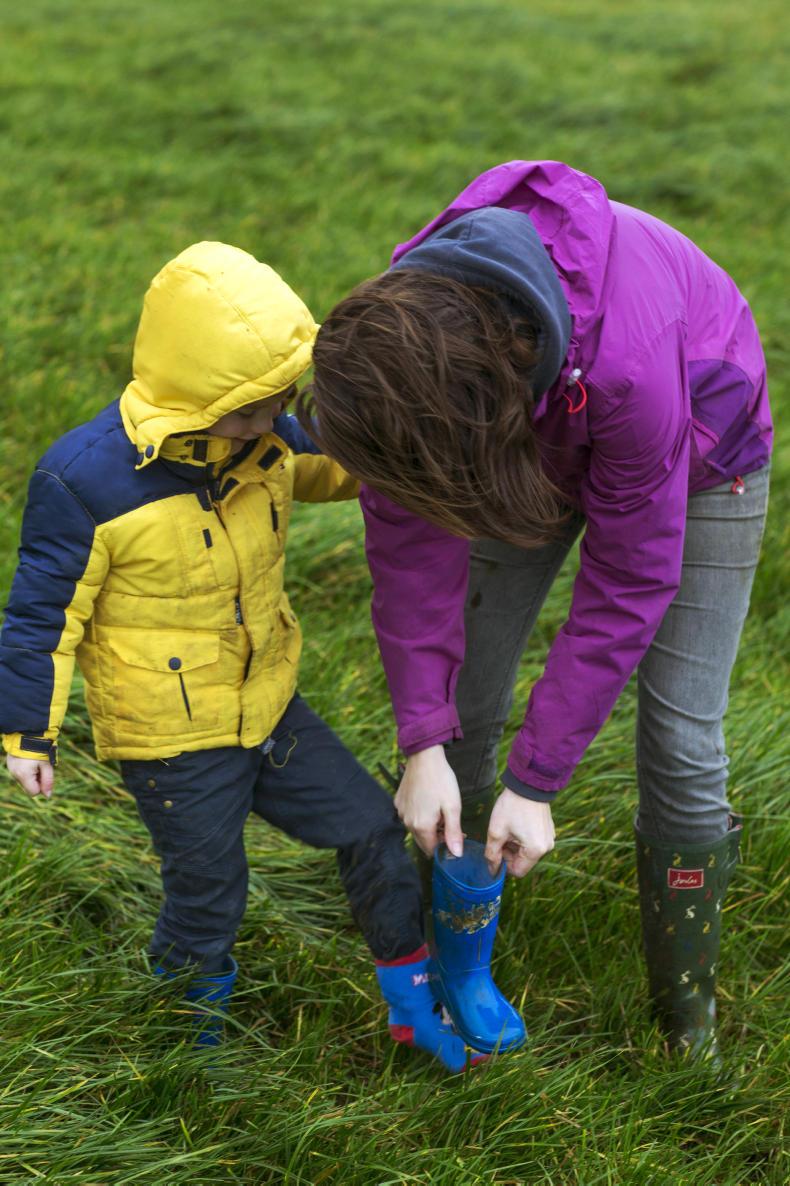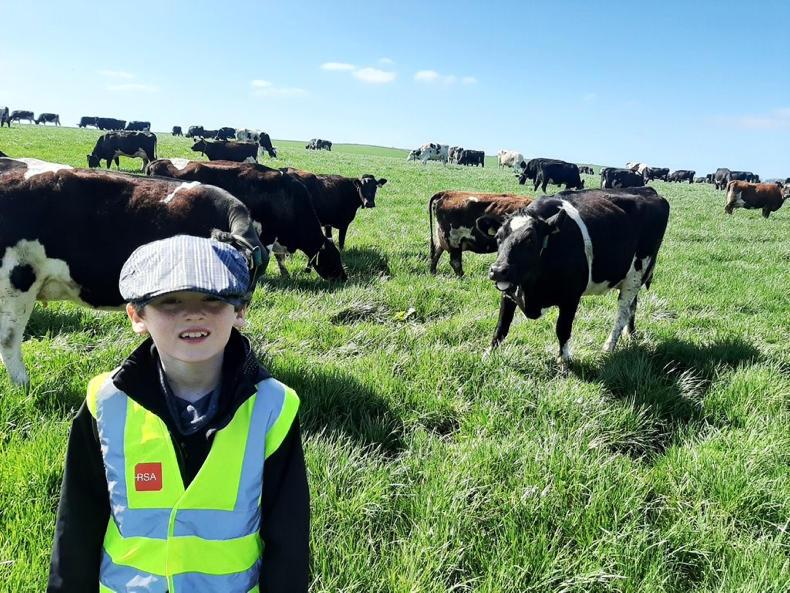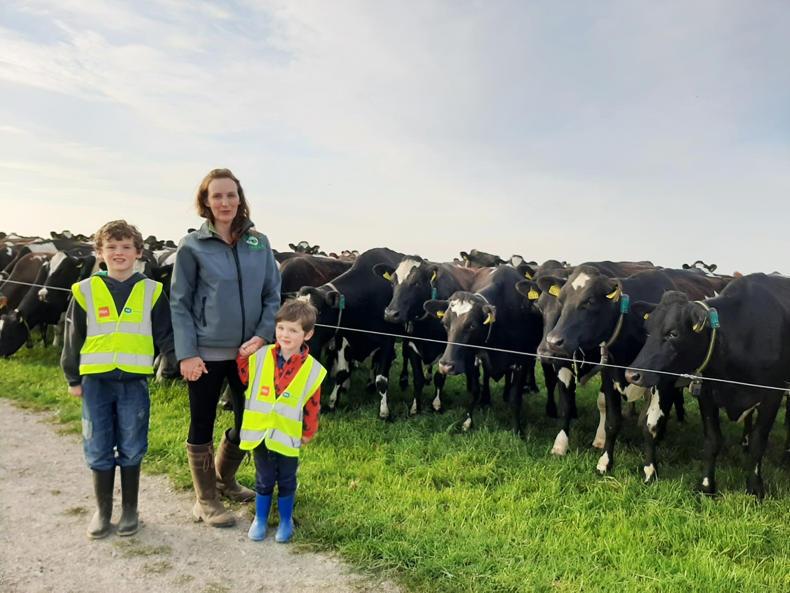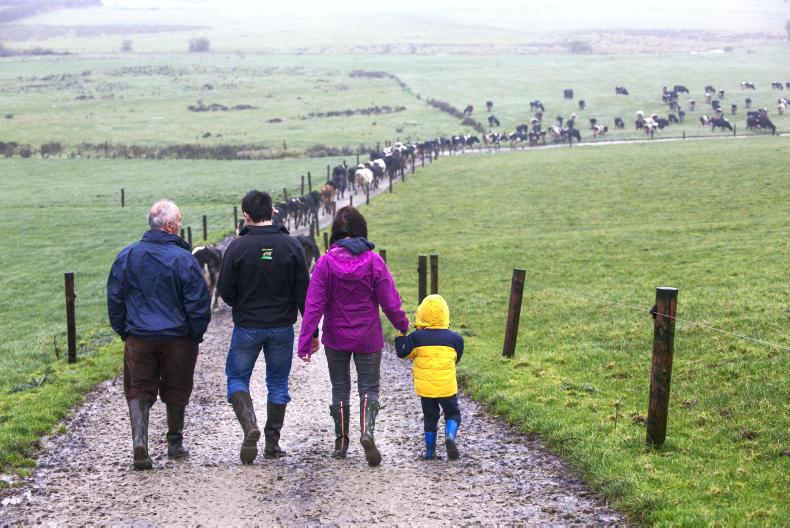Since the schools closed last March, farming families have had to negotiate the tricky situation of keeping their children at home, perhaps run an office from the living room, as well as continue to look after the farm.
Whatever your situation, since the COVID-19 pandemic caused a nationwide lockdown, there are more children than ever spending time on Irish farms. It is a worrying time for everyone and parents have been doing their best to keep their children safe when taking them on to the farm.
Jennifer Payne is one such parent, married to Ed, they have two children, Ben (eight) and Aaron who is nearly four. “When we lived in Ballymoe, Co Roscommon, the house was attached to the farm, so as soon as our eldest son Ben started coming out with us, he was taught that there was a cut-off point that he wasn’t allowed to go past,” says Jennifer.

Jennifer helps her son Ben.
There is a certain gate on the Payne’s farm that is visible and easy for a child to understand, so they used that to illustrate where young Ben should stop. “The earlier you can say to them, ‘Don’t go past here’, the better really.”
The family later relocated to Hilltop Dairies, Tulsk – also in Roscommon – but here the farm is detached from the house, meaning that there is now a road to cross in order to enter the farm, adding an extra danger. “The boys might run up ahead of me as we’re coming out the driveway, but they know to stop at the front gate.”
Jennifer says there are many points, both at home and on the farm where her children must stop and wait until they are accompanied by an adult and that these are very important rules that the kids are reminded of daily.
“It’s quite a big thing for them, the constant reminders to wait for people, rather than just letting them run out the gate or across the road. It’s about having boundaries.”
As all parents will know, consistency is key when getting children into a good routine. The Payne family held an open day on their farm a couple of years ago and CEO of Agri-kids Alma Jordan held a talk with all the visiting children.
Since then, many more school children have visited their farm in school-groups and Jennifer makes sure that farm safety is one of the main aspects of learning about the farm.

Jennifer encourages the kids to wear high-vis jackets on the farm.
“I find that children are great for pointing out dangers on a farm. They will be the first to tell you if you’re doing something that they’ve been warned not to do. They’re really good advocates for farm safety,” says Jennifer.
Accidents
According to the Health and Safety Authority (HSA), between 2010 and 2019, there have been 21 child deaths on farms. This makes up 9.8% of all farm fatalities. Two of the biggest causes of these accidents involved tractors and other farm machinery.
Eight children were involved in incidents involving tractors, while other machinery caused nine fatalities. Drowning, gas, electricity and falling objects were cited as the other leading causes of child fatalities on farms.

“The age profile of those killed is of serious concern,” says the Health and Safety Authority (HSA). “The old and the young are exceptionally vulnerable to death and injury on Irish farms.” The HSA have published a code of practice on preventing accidents to children and young persons in agriculture that can be found on their website.
New perspective
Jennifer believes that coming from a city background may have helped her to identify dangers as she might see things from a different point of view. “Ed has grown up on a farm and he’s used to the environment, so what is normal to farmers, I wouldn’t be used to. I would be a little extra cautious and see more dangers.”
Jennifer moved to Ireland from her home town of Nottingham in the UK, but she has always kept horses, so she isn’t a total stranger to rural life. To illustrate her point, Jennifer would consider cows to be an unreliable animal, whereas many farmers would consider horses to be far more of a danger.

Jennifer on the farm with her sons Ben and Aaron.
Jennifer also has the discipline of wearing horse-riding helmets and high-visibility jackets, as is the norm for riders, so she applies the same logic with her children on their farm.
“I understand that it’s harder for people who live on the farm to insist on high-vis jackets, I guess it’s slightly easier for us as they have to cross the road. Nobody’s perfect, it doesn’t always happen, but we try our best.”
One of her safety tips to the children is to go the other way and stand in a safe place if they can hear approaching machinery. Curiosity and excitement might cause them to run in front of a machine to where the driver can’t see.
Jennifer’s children love helping out on the farm and they are allowed to feed lambs or bed the calves, but as Jennifer says: “A lot of it is common sense, it’s daily reminders and remembering that they are just children and kids simply aren’t old enough to know what’s going to hurt them.”
To download the HSA’s Code of Practice on Preventing Accidents to Children and Young Persons in Agriculture, visit
www.hsa.ie
For lots of resources on farm safety and life on the farm, look up the Agri Aware
DigIn campaign agriaware.ie/digin
Read more
Weekly Podcast: marts go online and farm safety in summer
Guidelines for safe shearing in the pipeline
Since the schools closed last March, farming families have had to negotiate the tricky situation of keeping their children at home, perhaps run an office from the living room, as well as continue to look after the farm.
Whatever your situation, since the COVID-19 pandemic caused a nationwide lockdown, there are more children than ever spending time on Irish farms. It is a worrying time for everyone and parents have been doing their best to keep their children safe when taking them on to the farm.
Jennifer Payne is one such parent, married to Ed, they have two children, Ben (eight) and Aaron who is nearly four. “When we lived in Ballymoe, Co Roscommon, the house was attached to the farm, so as soon as our eldest son Ben started coming out with us, he was taught that there was a cut-off point that he wasn’t allowed to go past,” says Jennifer.

Jennifer helps her son Ben.
There is a certain gate on the Payne’s farm that is visible and easy for a child to understand, so they used that to illustrate where young Ben should stop. “The earlier you can say to them, ‘Don’t go past here’, the better really.”
The family later relocated to Hilltop Dairies, Tulsk – also in Roscommon – but here the farm is detached from the house, meaning that there is now a road to cross in order to enter the farm, adding an extra danger. “The boys might run up ahead of me as we’re coming out the driveway, but they know to stop at the front gate.”
Jennifer says there are many points, both at home and on the farm where her children must stop and wait until they are accompanied by an adult and that these are very important rules that the kids are reminded of daily.
“It’s quite a big thing for them, the constant reminders to wait for people, rather than just letting them run out the gate or across the road. It’s about having boundaries.”
As all parents will know, consistency is key when getting children into a good routine. The Payne family held an open day on their farm a couple of years ago and CEO of Agri-kids Alma Jordan held a talk with all the visiting children.
Since then, many more school children have visited their farm in school-groups and Jennifer makes sure that farm safety is one of the main aspects of learning about the farm.

Jennifer encourages the kids to wear high-vis jackets on the farm.
“I find that children are great for pointing out dangers on a farm. They will be the first to tell you if you’re doing something that they’ve been warned not to do. They’re really good advocates for farm safety,” says Jennifer.
Accidents
According to the Health and Safety Authority (HSA), between 2010 and 2019, there have been 21 child deaths on farms. This makes up 9.8% of all farm fatalities. Two of the biggest causes of these accidents involved tractors and other farm machinery.
Eight children were involved in incidents involving tractors, while other machinery caused nine fatalities. Drowning, gas, electricity and falling objects were cited as the other leading causes of child fatalities on farms.

“The age profile of those killed is of serious concern,” says the Health and Safety Authority (HSA). “The old and the young are exceptionally vulnerable to death and injury on Irish farms.” The HSA have published a code of practice on preventing accidents to children and young persons in agriculture that can be found on their website.
New perspective
Jennifer believes that coming from a city background may have helped her to identify dangers as she might see things from a different point of view. “Ed has grown up on a farm and he’s used to the environment, so what is normal to farmers, I wouldn’t be used to. I would be a little extra cautious and see more dangers.”
Jennifer moved to Ireland from her home town of Nottingham in the UK, but she has always kept horses, so she isn’t a total stranger to rural life. To illustrate her point, Jennifer would consider cows to be an unreliable animal, whereas many farmers would consider horses to be far more of a danger.

Jennifer on the farm with her sons Ben and Aaron.
Jennifer also has the discipline of wearing horse-riding helmets and high-visibility jackets, as is the norm for riders, so she applies the same logic with her children on their farm.
“I understand that it’s harder for people who live on the farm to insist on high-vis jackets, I guess it’s slightly easier for us as they have to cross the road. Nobody’s perfect, it doesn’t always happen, but we try our best.”
One of her safety tips to the children is to go the other way and stand in a safe place if they can hear approaching machinery. Curiosity and excitement might cause them to run in front of a machine to where the driver can’t see.
Jennifer’s children love helping out on the farm and they are allowed to feed lambs or bed the calves, but as Jennifer says: “A lot of it is common sense, it’s daily reminders and remembering that they are just children and kids simply aren’t old enough to know what’s going to hurt them.”
To download the HSA’s Code of Practice on Preventing Accidents to Children and Young Persons in Agriculture, visit
www.hsa.ie
For lots of resources on farm safety and life on the farm, look up the Agri Aware
DigIn campaign agriaware.ie/digin
Read more
Weekly Podcast: marts go online and farm safety in summer
Guidelines for safe shearing in the pipeline










 This is a subscriber-only article
This is a subscriber-only article










SHARING OPTIONS: